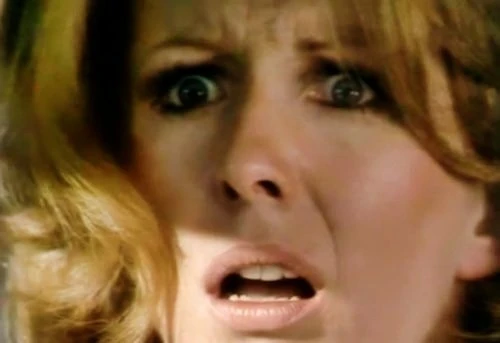
The Stone Tape
1972 - United KingdomWhen the BBC approached Nigel Kneale to come up with a suitable play for Christmas, the creator of Quatermass decided to write a traditional ghost story with a difference. One that leaned heavily on technology. It wasn't a million miles away from Quatermass and the Pit in the way that science unleashes supernatural forces from the past. But rather than go down the full science fiction route with aliens as the chief antagonisers, Kneale took something of a Dickensian approach by placing the action in a Victorian mansion with a reputation for being haunted, a Scrooge-like figure, and a ghostly image.

Computer programmer Jilly Greeley (Jane Asher) arrives, along with the rest of her team, for her first day at work at Taskerlands, a Victorian mansion recently purchased by Ryan Electric Products, a company that wants to develop a recording medium for data storage that will replace magnetic tape. When they arrive, Peter Brock (Michael Bryant), the Director of Research, is unhappy to discover from Collinson (Iain Cuthbertson), that work on a room designated as a computer storage area has been left unfinished. The reason, he claims, is because the builders refused to work in it because they believed it was haunted.

On entering the room, which was previously used to store US Army rations, the researchers discover a stone staircase behind some panelling and a child's note to Father Christmas asking for something to 'go away.' Left alone in the room, Jill hears footsteps and then sees the image of a screaming Victorian maid falling from the stone steps. Researching the property at a local church, they discover that the room had previously been exorcised - two years after the tragedy of a maid, Louisa Hanks, who fell to her death there in 1890.

Brock tells his team to use their electronic equipment to investigate further and they soon realise they have found their new recording medium; the stone in the room, which has trapped the moment of Louisa's death. As Brock pushes his team to bombard the room with their technology, in order to find the secret of the 'stone tape' and gain control of the medium, Jill senses that their heavy handed approach has wiped Louisa's image. Brock's failure to gain control are compounded further when he is confronted by Crawshaw (Reginald Marsh) who wants to take over part of Taskerlands with a rival research team working on a new washing machine. When his superiors lose confidence in Brock and tell him to share Taskerlands with the rival team, he puts a stop to the work on the stones and tells his team to return to their originally intended research. However, Jill continues to work on the haunting data and realises there is far more to it than any off them originally thought.

Discovering evidence of another exorcism in 1760, Jill realises that the phenomenon in the room is far older than the house itself and might well be the thing that made Louisa fall to her death. Obsessed with the data, Jill continues the investigation on her own. She realises that the stones can capture recordings repeatedly and that Louisa's death was just the latest recording. But Brock dismisses her research declaring that she is having a nervous breakdown and forces her to take two months leave. Returning to the storeroom one last time, Jill is confronted by a malevolent and degraded image from the past. Terrified, she climbs up the stone steps and falls to her death, calling out Brock's name as she falls.

After Jill's funeral and an inquest into her death, Brock orders all her research to be destroyed. He returns to the room on his own and, to his horror, hears Jill's voice screaming his name. The most recent recording on the stone tape...

Newly appointed Head of Drama at the BBC, Christopher Morahan, approached Nigel Kneale in mid-1972 to write a 50-minute play to be broadcast over the Christmas period as part of the horror anthology series Dead of Night. Kneale duly submitted his idea under the title Breathrough, but during development of that idea it was felt that the play would sit better as a stand-alone 90-minute production. Kneale later revealed that one of the inspirations for the setting of his story was a visit to the BBC's own electronic research establishment at Kingswood Warren in Surrey. "I went down there to see how they all did it. It was exactly such a place full of people beavering away inventing new recording media." The play was directed by Peter Sasdy, a Hungarian director of Hammer horror films which included Taste the Blood of Dracula (1969), Countess Dracula (1971) and Hands of the Ripper (1971). He also handled the BBC adaptation of Wuthering Heights. Sasdy had previously overseen 30 episodes of Emergency-Ward 10 in the late 1950s and later in his career he directed two Adrian Mole series.
The location work was shot entirely on video by an Outside Broadcast unit. A remount was required in early December, but actor Michael Bates was unavailable. As a result, the script was quickly rejigged and his characters’ dialogue was given to Iain Cuthbertson's character Collinson.

On broadcast, The Stone Tape was very well received. The Evening Standard called it "One of the best plays of the genre ever written. Its virtues aren't just the main spine of the story, but the way the characters shift as in real life." Perhaps a little dated since it was made, The Stone Tape still stands as a quintessential Christmas ghost story which graces the genre with a genuine new slant on a much loved and revered formula, and it is possibly Nigel Kneale's best work outside of his legendary Quatermass series.
Seen this show? How do you rate it?
Seen this show? How do you rate it?
Published on November 30th, 2020. Written by Laurence Marcus for Television Heaven.










